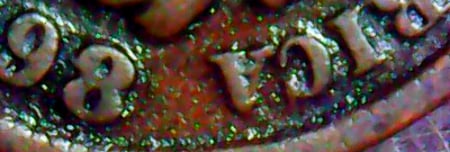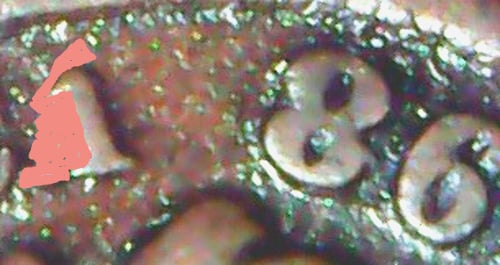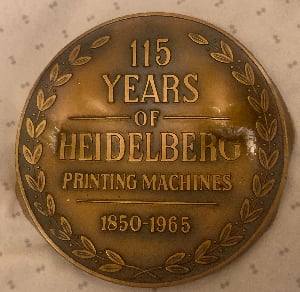Anyone ever question a 1898 U.S. cent's obverse, stippling of the last A in AMERICA
 emeraldATV
Posts: 5,140 ✭✭✭✭✭
emeraldATV
Posts: 5,140 ✭✭✭✭✭
Stippling -
Is a drawing or printing technique that uses a series of small dots to create images and tonal or shading effects. The technique is versatile, used by artists to create detailed drawings and by pressman to render images.
Does anyone have a photo of the letter A font used in AMERICA, on a 1898 cent ?
These photo's may show a time and cost saver method, if done exactly, could go undetectable back in the day.
Two thoughts come to mind because, I've been there, done that.
First.
No margin for error.
Second.
I see a number 1 font, resting on top of a, failing, capitol letter A font.
What's in your thoughts ?
.
.
.
0
Comments
you're seeing things
May I reserve that right on this one ?
What's throwing me into this thread, is a hook image, or small decorative stroke, called a"serif," on the head of the A font.
I'm going to put it into a negative filter using my other PC.
I may be eating all of this time and work.
I don't even think I have this coin any more. I think I donated something with this date about a year ago when a folder was passed around the forum asking to be filled for a good cause.
No biggie.
Pareidolia
Sometimes a damaged or grease- filled "A" is just that. It doesn't have to be an engraving of the Mint Director's mistress just because your mind wants to interpret the image that way.
All comments reflect the opinion of the author, even when irrefutably accurate.
Could it be die wear or erosion?
Worry is the interest you pay on a debt you may not owe.
"Paper money eventually returns to its intrinsic value---zero."----Voltaire
"Everything you say should be true, but not everything true should be said."----Voltaire
I thought you were going to ask him how long he's been off his meds.
Disclaimer: I'm not a dealer, trader, grader, investor or professional numismatist. I'm just a hobbyist. (To protect me but mostly you! 🤣 )
Just wondering, why is all that green on the coin -- I would be compelled to use acetone and then Verdi-Care.
And yeah, I'm probably off my meds.
A.1. was officially registered as a trademark in the US in 1895, and imported and distributed in the United States by G. F. Heublein & Brothers in 1906.
What ?
Here is a MS-67+ RD from PCGS CoinFacts
https://www.pcgs.com/coinfacts/coin/1898-1c-rd/2201
A3 (last A in AMERICA) has a fairly level surface in this high grade coin, although the right side may be higher than the left side.
In addition, the right side of A3 is slanted relative to its feet (serifs),
unlike the 1 in the date, where the serifs are at a 90 degree angle to the upright.
And the 1 in date is taller than A3.
I agree it is wise to look at high grade coins to see the undamaged letter shapes,
rather than to draw conclusions from a lower grade circulated coin like yours.
Your coin may have had post-mint impact damage or selective acid corrosion on the left side of the A.
Thanks for that high grade information, @yosclimber !
I'm not going into it's rabbit hole, until I have the coin in hand, for a better look using photo's.
I know its here, and until I come across it, then, I'll rethink my next move.
This thread started as I was cruising some photo's from awhile back, with this image clear as a loop.
For now, is for another time.
Thanks again every one.
Answered ?
Experienced collectors typically refer to your "stippling" as pitting and verdigris, both of which are quite common on low-grade copper coins. If you want to show that stippling was used on these dies, then show that it exists on high-grade uncs.
@Rittenhouse said-
- "to show that stippling was used on these dies, then show that it exists on high-grade uncs".
I would "GUESS" a high grade, die material, is used just for the low mintage, high-graded coins
with no evidence of public handling, thus labeled as uncirculated .
The criteria addressed during the make ready strike's or press checks must be signed off and filed by someone who's knowledge exceeds most pressman in all phases of production of the product.
Press checks (die inspections ? ) consume time with a principle and standard by which something may be judged or decided.
I don't think any pressman would cross that line. if ?
Now the business die's and it's production ?
HANG AND BANG BABY, were burning daylight.
Just my thoughts.
Your guesses are incorrect. Lower grade coins are those that remained in circulation for long enough to wear the surfaces. High grade coins were pulled out by collectors shortly after they appeared and thus have little to no wear. Both high and low grade coins were struck using the same dies.
As to the rest, I am not sure what you are trying to say.
@ Rittenhouse said,
 This thread I started will be addressed again when the exact 1898 U.S. cent is found to shed more light if needed. Thanks for sticking with it.
This thread I started will be addressed again when the exact 1898 U.S. cent is found to shed more light if needed. Thanks for sticking with it.
"High grade coins were pulled out by collectors shortly after they appeared
and thus have little to no wear".
.
Specifications:
Designer: James Barton Longacre.
Mint: Philadelphia.
Metal Composition: 95% Copper, 5% Tin and Zinc.
Diameter: 19.00 millimeters.
Weight: 3.11 grams.
Edge: Plain.
Year of Issue: 1898.
Proof Mintage 1,795
As for the rest... could be the X factor in question ? (?)
Mint Mintage 49,823,079
Collectors are warned to be very careful when studying this coin thus many problems were addressed during it's production. One being it's composition vs strike.
I'll be back.
I can't be sure, but here's one, full size, S mm (?).


.
.
What are your thoughts on pareidolia?
https://en.wikipedia.org/wiki/Pareidolia
Oh man, a truly horrible malady and pretty much the bane of mankind. I had a near fatal case as a new collector. Fortunately more experienced friends performed a voodoo exorcism (aka mentoring) and I got better.
.


To qualify as an expert witness,
a person must demonstrate specialized knowledge, skill, experience, training, or education in a field relevant to the case.
Beyond foundational knowledge, other important factors include the witness's ability to communicate clearly, remain professional, and present an unbiased testimony.
45 + years of maintaining quality and perfection with specialized knowledge of a industry skill,
viewing, color, errors, relevant to a case.
A professional color blind test addresses not only color, but an image, which the color protects.
And if one can not view the correct color of the card the image suffers.
I was only approached twice with this test. Mandatory backround check.
.
.

Are you saying you have expert witness level skills for analyzing coin photos?
Given that you don't respond to my points directly, I don't believe this is the case.
"I do think I could fall into that skill set". So, yes.
I'm a modest and easy kinda guy. If you think I'm on some kinda head trip ? Humor me.
I've been researching with photo's of coins for over five years now.
After the first three of those years,
I realized, this hobby is just an extension of my professional duties.
Remembering those press checks, proofs, and customer relations of over 25,000 plates, negatives, and ink mixtures, does make me brag "yes" and I'm retired.
PS..... What bugs me worse, is office politics.
@yosclimber, I still feel that I'm a babe in the woods following half eaten, covered bread crumbs.
I do read your comments.